When it comes to choosing the right tires for your Yamaha FJR1300, you know that performance and durability are non-negotiable. You’ll find that options like the Pirelli Angel ST and Dunlop Sportmax GPR-300 stand out for their grip and resilience, catering to a variety of riding conditions. As you explore further, you’ll discover how tires like the Kenda KM1 and Pirelli Diablo Rosso 3 can elevate your riding experience. But what factors should you consider to guarantee you make the best choice for your needs?
Quick Takeaways
- Pirelli Angel ST tires offer superior grip and durability, making them a top choice for performance in various weather conditions.
- Dunlop Sportmax GPR-300 tires provide exceptional handling and traction specifically designed for the Yamaha FJR1300.
- Michelin City Grip 2 tires ensure reliable all-season performance with a long lifespan for both front and rear applications.
- Kenda KM1 tires excel in all-weather performance, featuring a directional tread design for enhanced stability and quick warm-up.
Pirelli Angel ST Sport Touring Motorcycle Tires (Two Pack)
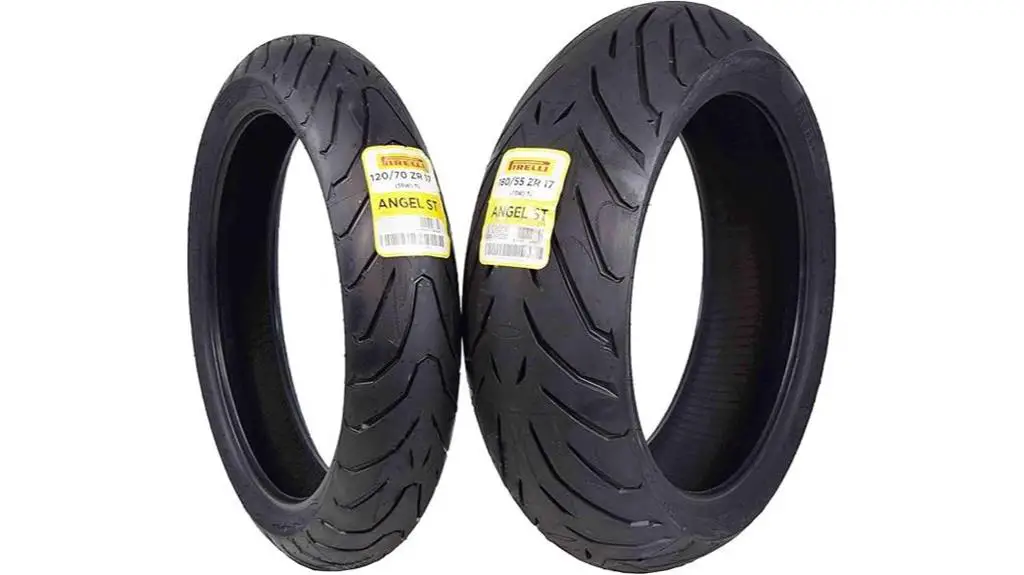
The Pirelli Angel ST Sport Touring Motorcycle Tires are an exceptional choice for Yamaha FJR1300 riders seeking superior grip and performance in both dry and wet conditions.
Designed with a high silica content compound, these tires provide excellent traction in varying temperatures. Their innovative profile guarantees neutral handling and uniform performance across all road conditions.
Riders appreciate the durability, reporting smooth rides and confidence while maneuvering curves and wet surfaces. With a 4.8 out of 5-star rating, customer feedback consistently praises the tires’ reliability and mileage.
Additionally, the product’s innovative design indicates residual lifespan, making it a practical choice for those who value long-lasting performance.
Overall, the Pirelli Angel ST tires stand out as a top-tier option for sport touring enthusiasts.
Best For: Sport touring motorcycle riders, particularly those with Yamaha FJR1300, seeking reliable grip and performance in diverse weather conditions.
Pros:
- High silica content compound offers excellent traction in both dry and wet conditions.
- Innovative design indicates residual lifespan, helping riders monitor tire wear effectively.
Cons:
- Higher price point compared to some other touring tire options on the market.
- Limited availability in specific sizes may restrict options for some riders.
MICHELIN City Grip 2 Front/Rear Combo – 120/70-14 (61S)
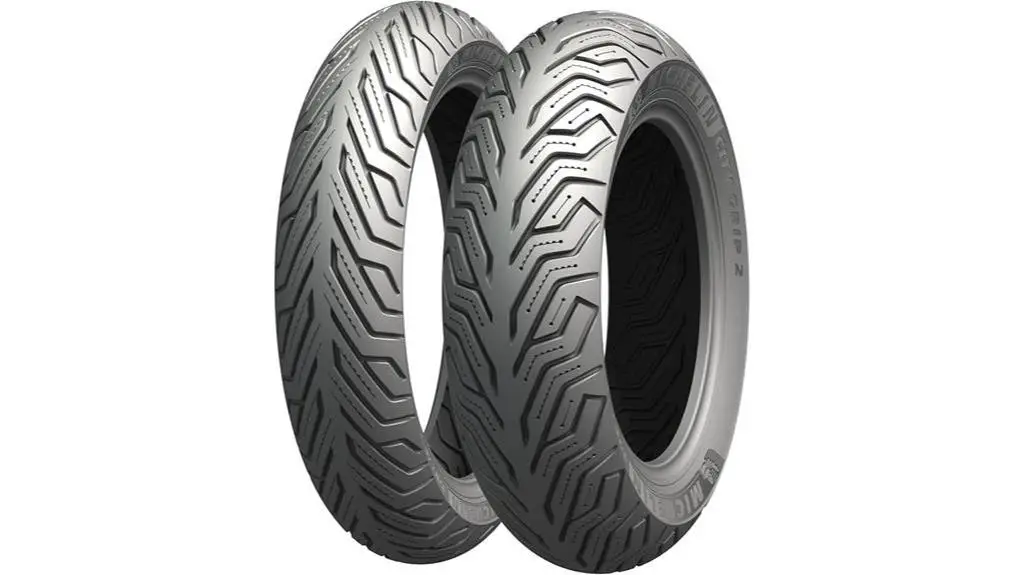
Designed for superior all-season traction, the MICHELIN City Grip 2 Front/Rear Scooter Tire – 120/70-14 (61S) is an excellent choice for riders seeking reliability and performance in both wet and dry conditions.
With its silica-based compounds and shark tooth sipes, this tire provides enhanced grip on slippery surfaces, including painted lines.
Weighing only 8.9 pounds, it supports a load capacity of 567 pounds, making it versatile for various scooters.
Users appreciate the tire’s longevity, often achieving up to 8,000 miles for the rear and 16,000 miles for the front.
Rated 4.5 out of 5 stars, it’s a popular choice among manufacturers, ensuring riders can trust its performance and durability.
Best For: Riders looking for a reliable scooter tire that performs well in all weather conditions and offers excellent longevity.
Pros:
- Enhanced grip on wet and slippery surfaces due to silica-based compounds and shark tooth sipes.
- Long-lasting performance, with users reporting up to 8,000 miles for rear and 16,000 miles for front tires.
Cons:
- Potential measurement inaccuracies with sidewall dimensions may lead to overinflation and blowout risks.
- Some users have reported experiencing rapid wear and blowouts, raising concerns about quality control.
Dunlop Sportmax GPR-300 Motorcycle Tire Set
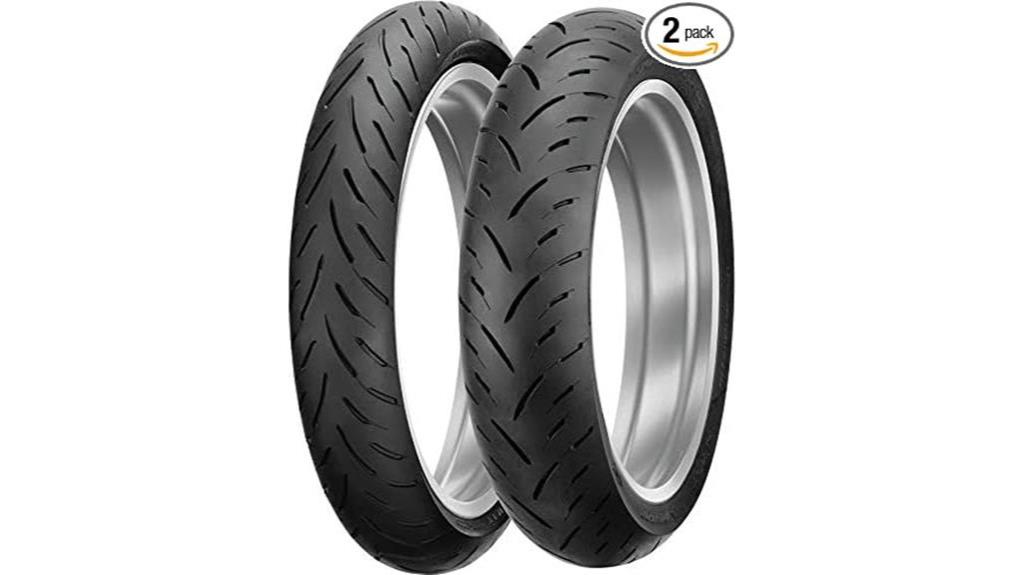
Offering exceptional grip and handling, the Dunlop Sportmax GPR-300 Motorcycle Tire Set is an ideal choice for Yamaha FJR1300 riders looking to enhance their street performance.
This high-performance radial tire set, designed for sport bikes, comes in sizes 120/70ZR17 for the front and 180/55ZR17 for the rear.
Its advanced Joint less Band (JLB) construction guarantees smooth performance and a consistent tire contact patch, improving handling and responsiveness.
The aggressive tread pattern not only boosts performance in wet and dry conditions but also enhances the bike’s appearance.
With a customer rating of 4.7 out of 5 stars, riders appreciate its price, performance, and shipping speed, although some have noted installation challenges with the rear tire.
Best For: Riders of sport bikes, particularly those looking to enhance street performance and grip in varying weather conditions.
Pros:
- High-performance radial design offers enhanced grip in both wet and dry conditions.
- Advanced construction ensures improved handling and responsiveness.
Cons:
- Some users report installation challenges with the rear tire.
- Limited load capacity may not suit heavier bikes.
Dunlop Sportmax GPR-300 Radial Front Motorcycle Tire (120/70ZR-17)
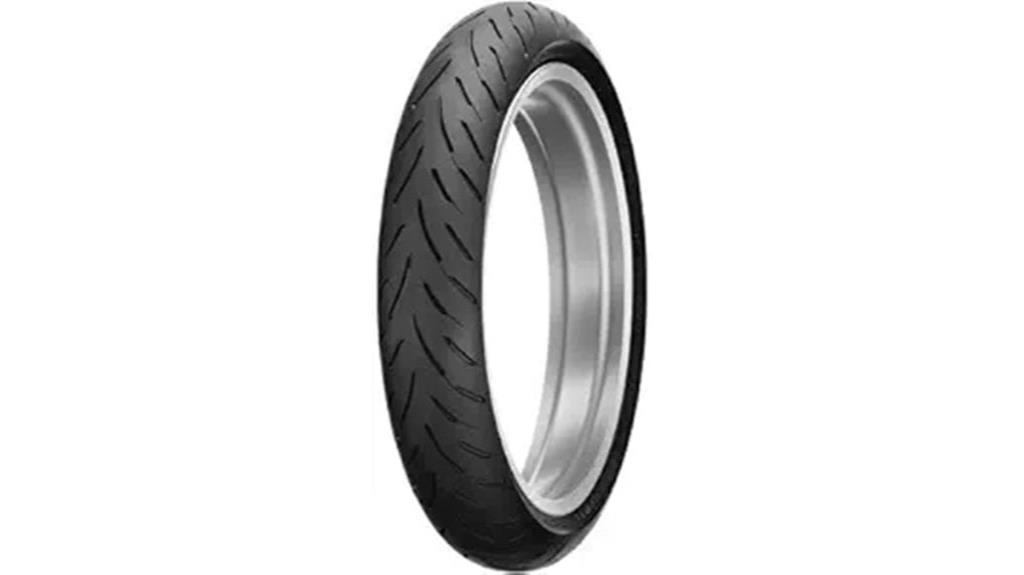
With its high-performance radial technology, the Dunlop Sportmax GPR-300 Radial Front Motorcycle Tire (120/70ZR-17) provides Yamaha FJR1300 riders exceptional grip and handling in both wet and dry conditions.
This tire is specifically designed for Yamaha FJR1300 models from 2004 to 2006, making it an ideal choice for those seeking performance.
The aggressive sport-derived tread pattern not only enhances the bike’s appearance but also considerably improves traction.
With an advanced Jointless Band (JLB) construction, the tire guarantees smooth performance and responsiveness during sport riding.
Riders appreciate the consistent contact patch that optimizes handling, making this Dunlop tire a top choice among enthusiasts.
Backed by a 30-day return guarantee, it offers confidence with every ride.
Best For: Riders of Yamaha FJR1300 models from 2004 to 2006 looking for high-performance tires that enhance grip and handling.
Pros:
- Excellent grip in both wet and dry conditions due to advanced radial tire technology.
- Aggressive tread pattern improves traction and enhances the bike’s visual appeal.
Cons:
- Limited compatibility, specifically designed for Yamaha FJR1300 models from 2004 to 2006.
- Higher price point compared to standard motorcycle tires.
Kenda KM1 Sport Touring Motorcycle Tire Set
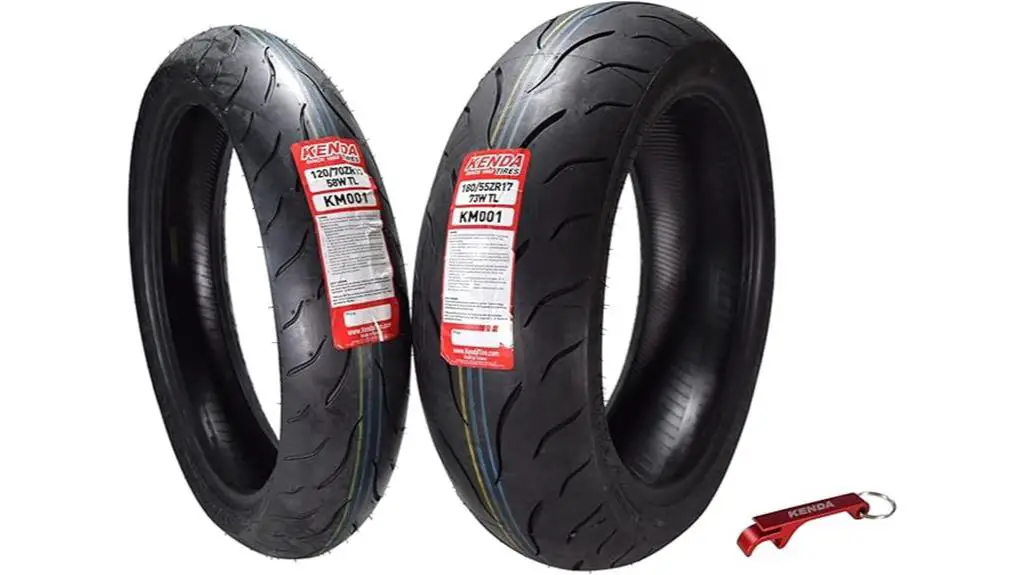
The Kenda KM1 Sport Touring Motorcycle Tire Set delivers exceptional all-weather performance, making it an ideal choice for Yamaha FJR1300 riders who value stability and grip in diverse riding conditions.
With a directional tread design and a quick warm-up capability, these tires excel in both dry and wet conditions. Weighing 29.5 pounds, the set supports a load capacity of 805 pounds, ensuring durability for long tours.
The optimized apex geometry enhances high-speed stability, while responsive handling facilitates agile maneuvering.
Riders appreciate the KM1’s performance, reflected in an impressive average rating of 4.7 out of 5 stars from over 550 reviews.
Overall, the Kenda KM1 is a reliable choice for those seeking versatility and performance in their touring tires.
Best For: The Kenda KM1 Sport Touring Motorcycle Tire Set is best for touring riders seeking reliable performance and stability in various weather conditions.
Pros:
- Excellent grip and stability in both dry and wet conditions.
- Quick warm-up capability for enhanced performance in lower temperatures.
Cons:
- Initial stiffness may be noted by some riders before the tires break in.
- Shipping delays have been reported by a few customers.
Pirelli Diablo Rosso 3 Rear Motorcycle Tire for Yamaha FJR1300
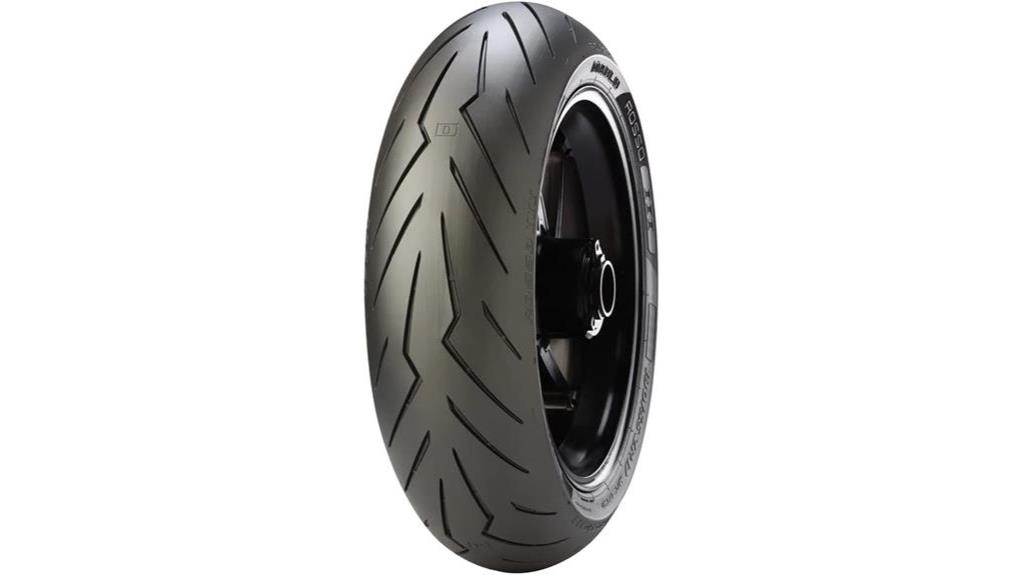
Designed specifically for the Yamaha FJR1300, the Pirelli Diablo Rosso 3 rear tire delivers exceptional grip and performance, thanks to its advanced bi-compound design and race-inspired technology.
This tire features a wide side soft stripe that enhances grip during mid-lean angles, while a large footprint area improves adherence.
Derived from World Superbike Championship technology, it offers race-like handling and quick lean-in capabilities.
The high-performance Silica compounds guarantee peak grip across a wide temperature range, while the directional tread pattern promotes uniform wear and consistent performance.
Weighing just 9.5 lbs, this tubeless tire supports a load rating of 805 lbs and a speed rating of 168 mph, making it an excellent choice for riders seeking reliability and performance.
Best For: Riders of the Yamaha FJR1300 looking for a high-performance rear tire that excels in grip and handling.
Pros:
- Advanced bi-compound design enhances grip during mid-lean angles.
- Race-inspired technology offers quick lean-in capabilities and improved handling.
Cons:
- Specific fitment limited to Yamaha FJR1300 models (2004-2006).
- Requires a break-in period of 100 miles to achieve optimal performance.
Factors to Consider When Choosing Tires for Yamaha FJR1300
When you’re choosing tires for your Yamaha FJR1300, it’s essential to think about several key factors.
You’ll need to take into account tire size compatibility, tread patterns that suit your riding style, and the weather conditions you typically face.
Don’t forget to check load capacity and performance features to guarantee you’re getting the best fit for your motorcycle.
Tire Size Compatibility
Choosing the right tire size for your Yamaha FJR1300 is fundamental for guaranteeing peak performance and safety on the road. The typical sizes you’ll need are 120/70ZR17 for the front and 180/55ZR17 for the rear. Sticking to these specifications is critical for maintaining stability and safety during your rides.
Tire size compatibility directly influences your motorcycle’s handling characteristics. It impacts cornering stability and braking performance, which are essential for your overall riding experience. If you deviate from the recommended sizes, you might face issues like reduced grip, increased tire wear, and difficulties in maneuverability.
To avoid these potential problems, always consult your motorcycle’s manual or the manufacturer’s specifications before purchasing replacement tires. This guarantees you get the correct dimensions for your FJR1300 and helps you achieve the best possible performance on the road.
Tread Pattern Selection
Selecting the right tread pattern for your Yamaha FJR1300 is vital for maximizing grip and handling on various road conditions. A directional tread design can greatly enhance performance in wet conditions, effectively channeling water away from the contact patch for improved stability.
If you lean towards an aggressive riding style, consider a sport-derived tread pattern; it offers better cornering stability and responsiveness, perfect for those thrilling rides. You should also pay attention to the footprint area of the tread. Larger footprint areas can provide enhanced adherence during mid-lean angles, giving you better traction and control as you navigate curves.
Additionally, opting for tires with a bi-compound tread design can optimize grip across varying temperatures, ensuring you remain safe and confident regardless of the conditions.
Don’t forget the importance of regular inspection and maintenance of your tire tread depth. Worn tread can severely compromise your handling and safety, so keeping an eye on it is essential.
Weather Conditions Consideration
Considering the local weather conditions is essential for finding the right tires for your Yamaha FJR1300, as they can greatly impact grip and safety throughout your rides. If you often ride in wet conditions, look for tires with high silica content, as these provide better grip and performance year-round. For colder climates, choose tires designed for low-temperature performance to maintain grip and handling characteristics, ensuring a safer ride.
Evaluate the tread pattern carefully; directional treads are particularly effective at water drainage, which reduces the risk of hydroplaning on slick roads. If your rides frequently involve cornering, consider tires with bi-compound designs. These tires typically feature softer compounds on the sides, enhancing grip during turns—crucial for maneuvering in unpredictable weather.
Lastly, opt for tires that indicate residual lifespan. This feature helps you assess performance consistency over time, ensuring that your tires remain reliable as weather conditions change.
Load Capacity Requirements
Understanding load capacity requirements is fundamental for guaranteeing your Yamaha FJR1300 performs safely and effectively, especially when factoring in the weight of both the rider and any additional cargo.
The FJR1300 needs tires that can support a minimum load capacity of 805 pounds, particularly for the rear tire. This is essential for maintaining stability during your rides.
When selecting tires, it’s important to match the load ratings for both the front and rear tires. This balance guarantees maximum handling and performance, especially under varying weight conditions. Tire load capacity is typically indicated by a load index number; for example, a load index of 73 corresponds to that critical 805-pound maximum load.
Keep in mind that overloading your tires beyond their specified capacity can lead to decreased performance, increased tire wear, and even blowouts.
Regularly checking your tire pressure is also important. Make sure it aligns with the manufacturer’s specifications, as this will help maintain the load capacity and overall health of your tires.
Prioritizing load capacity won’t only enhance your riding experience but also keep you safe on the road.
Performance Features Importance
Performance features play an essential role in guaranteeing your Yamaha FJR1300 delivers ideal handling and stability, especially in diverse riding conditions. When choosing tires, you should focus on advanced tread patterns and silica compounds that enhance traction. These elements expand the contact area, which is essential for grip in both wet and dry conditions.
Look for high-performance tires that utilize a bi-compound design. This feature offers different grip levels at various lean angles, giving you the confidence to corner effectively. Additionally, pay attention to the tire’s load rating and pressure specifications. These factors determine how well the tire can support your motorcycle’s weight while maintaining peak performance.
Don’t overlook the importance of regular maintenance. Checking tire pressure and adhering to break-in periods can greatly impact tire longevity and performance.
Handling and Stability
Tires play a significant role in how your Yamaha FJR1300 handles and stays stable on the road, making it essential to choose the right options for your riding style.
When selecting tires, consider the construction type; radial tires typically offer better grip and stability, especially during cornering and high-speed maneuvers.
The tread pattern is another important factor. Directional designs enhance grip on wet surfaces, improving overall handling performance in various conditions.
Make sure the tire’s load rating matches your motorcycle’s weight, as using under-rated tires can compromise stability, particularly when loaded for touring or carrying a passenger.
Tire pressure is critical for stability as well; improper inflation can decrease handling precision and increase tire wear, negatively impacting responsiveness.
Installation and Maintenance
When choosing the right tires for your Yamaha FJR1300, paying attention to installation and maintenance is fundamental for guaranteeing safety and longevity.
Start by regularly checking your tire pressure; maintaining the correct PSI is essential for ideal performance and tire lifespan. A simple gauge can help you monitor this easily.
Follow the manufacturer’s recommended break-in period, usually around 100 miles. This helps your tires adapt to your bike and prevents issues like abrupt leaning or hard cornering.
It’s also crucial to inspect the tread depth frequently; verify it’s at least 2/32 inches for safe operation, especially on wet roads.
Proper alignment and balance of the tires are key to avoiding uneven wear and enhancing handling stability. If you notice any vibrations while riding, it may be time to check these aspects.
Additionally, remember to rotate your tires as recommended. This is particularly important if you often ride under varying conditions or styles, as it promotes even wear and maximizes tire life.
Price and Value Comparison
Choosing the right tires for your Yamaha FJR1300 involves not just understanding installation and maintenance but also evaluating price and value to guarantee you get the best performance for your investment.
When comparing prices, expect to see high-performance tires ranging from $150 to $300 each. This cost can vary based on brand and specifications, so it’s essential to shop around.
You should look for tires that strike a balance between performance and mileage. Many rear tires can last up to 8,000 miles, while front tires may go as far as 16,000 miles. This longevity can greatly enhance the overall value of your purchase.
Pay attention to customer ratings, as tires with ratings as high as 4.8 out of 5 stars often indicate strong satisfaction regarding performance and durability.
Additionally, consider warranties and return policies. Many options come with a 30-day return guarantee, allowing you to assess performance without financial risk.
Common Questions
How Often Should I Replace Tires on My Yamaha Fjr1300?
You should replace the tires on your Yamaha FJR1300 every 5,000 to 10,000 miles, but it really depends on your riding style and conditions.
Regularly check for tread wear, cracks, or bulges. If you notice any signs of damage or if the tread depth is below 2/32 of an inch, it’s time for new tires.
Keeping an eye on them helps guarantee your safety and enhances your bike’s performance.
What Is the Ideal Tire Pressure for Yamaha FJR1300 Tires?
The ideal tire pressure for your Yamaha FJR1300 typically ranges from 36 to 42 PSI, depending on the load and riding conditions.
You should check your owner’s manual for specific recommendations.
Maintaining the correct pressure guarantees peak performance, better fuel efficiency, and enhanced safety.
Don’t forget to check the pressure regularly, especially before long rides, to keep your tires in top shape and enjoy a smooth, comfortable ride.
Can I Mix Different Tire Brands on My Fjr1300?
Mixing different tire brands on your FJR1300 might seem like an easy fix, but it can create problems.
While some riders believe it’s okay, others swear by sticking to the same brand for safety and performance.
Different tires can have varying tread patterns and rubber compounds, affecting handling and grip.
To guarantee a smooth, safe ride, it’s best to use the same brand and model on both tires.
Your motorcycle deserves consistency!
What Is the Typical Lifespan of Yamaha FJR1300 Tires?
The typical lifespan of Yamaha FJR1300 tires usually ranges between 5,000 to 10,000 miles, depending on your riding style and conditions.
If you ride aggressively or in harsh environments, you might find they wear out faster.
Regularly checking tire pressure and maintaining proper inflation can extend their life.
Keeping an eye on tread wear and replacing them when necessary will help guarantee a safe and enjoyable ride.
Always prioritize safety over mileage!
How Do I Properly Store Tires When Not in Use?
Storing tires is like tucking your bike into a cozy bed for a long nap.
You’ll want to clean them thoroughly to remove dirt and debris, then stack them vertically or lay them flat away from direct sunlight.
Keep ’em in a cool, dry place, ideally on shelves or pallets to avoid deformation.
Don’t forget to cover them with a breathable material to protect from dust while letting them breathe!
Wrapping Up
In choosing the right tires for your Yamaha FJR1300, you’re not just picking rubber; you’re selecting the foundation of your riding adventures.
Each option, from the Pirelli Angel ST to the Dunlop Sportmax GPR-300, promises performance and durability, ensuring you’re ready to conquer the open road.
Remember, the right tire is like a trusted companion—supporting you through twists and turns, making every journey not just a ride, but an experience to cherish.